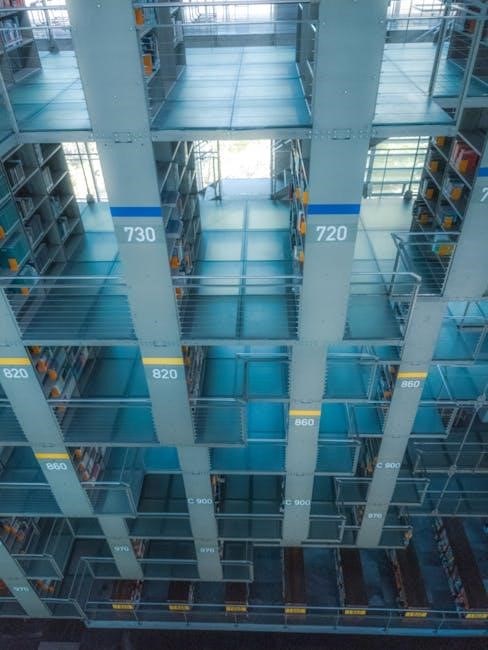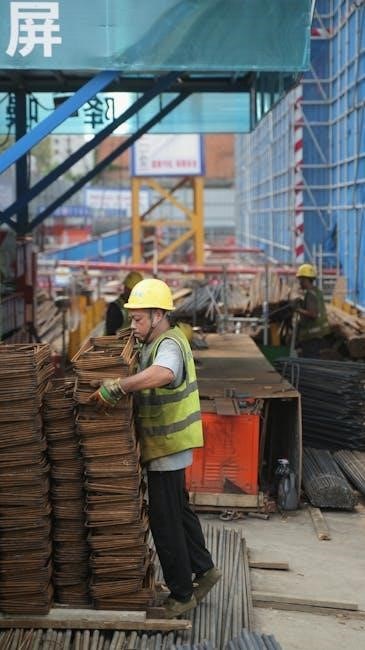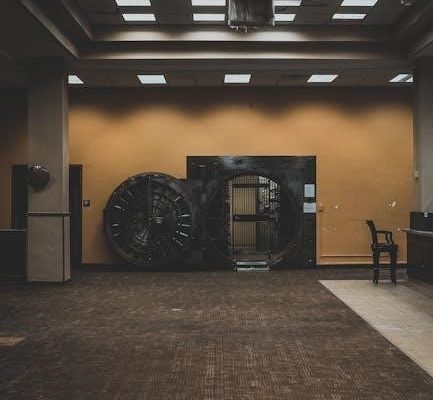The Concrete Reinforcing Steel Institute (CRSI) is a leading authority in reinforced concrete, providing essential guidelines through its Manual of Standard Practice for the industry since 1927.
1.1 Overview of CRSI and Its Role in Reinforced Concrete Construction

The Concrete Reinforcing Steel Institute (CRSI) is a prominent organization dedicated to advancing the use of reinforced concrete in construction. Established in 1927, CRSI serves as a vital resource for industry professionals, providing guidelines and standards through its Manual of Standard Practice. This manual is widely recognized as the go-to reference for estimating, detailing, fabricating, and placing reinforcing steel. CRSI’s role extends beyond documentation; it actively promotes education, research, and innovation to ensure the highest quality in reinforced concrete construction. By collaborating with other industry leaders, CRSI helps maintain the integrity and durability of structures, making it a cornerstone of modern building practices.
1.2 Historical Development of the Manual of Standard Practice
The Manual of Standard Practice has been a cornerstone of the reinforced concrete industry since its first publication in 1927. Developed by the Concrete Reinforcing Steel Institute (CRSI), the manual has evolved over the years to reflect advancements in materials, techniques, and industry standards. Early editions focused on basic practices for estimating, detailing, and placing reinforcing steel. Over time, updates incorporated new technologies, such as stainless steel reinforcement and improved corrosion mitigation methods. The 28th edition introduced enhanced guidelines for fabrication quality, while the 31st edition expanded bend shape libraries and tolerances. This continuous refinement ensures the manual remains a vital resource for professionals, aligning with modern construction demands and safety protocols.

Key Topics Covered in the CRSI Manual of Standard Practice
The manual covers essential topics like estimating, detailing, fabrication, and placement of reinforcing steel, ensuring compliance with industry standards for reinforced concrete construction.
2.1 Estimating and Detailing Reinforcing Steel
Estimating and detailing reinforcing steel are critical processes outlined in the CRSI Manual of Standard Practice. These steps ensure accurate material quantities and compliance with design specifications. The manual provides detailed guidelines for estimating rebar requirements, including calculations for lengths, weights, and costs. Additionally, it emphasizes the importance of precise detailing to avoid construction errors. Topics include bar bending schedules, lap splices, and stirrup placements, ensuring structural integrity. By adhering to these practices, professionals can optimize material usage and maintain project efficiency while meeting industry standards for reinforced concrete construction.
2.2 Fabrication and Placement of Reinforcing Bars
Fabrication and placement of reinforcing bars are essential steps in reinforced concrete construction. Fabrication involves cutting, bending, and assembling rebar to meet project specifications. The CRSI Manual of Standard Practice provides detailed guidelines for these processes, emphasizing precision to ensure proper fit and structural integrity. Placement requires careful positioning of the fabricated bars within concrete forms, securing them to prevent displacement during pouring. Proper spacing, alignment, and tie wiring are critical for maintaining design integrity. Quality control measures, including inspections, are highlighted to verify compliance with standards. Safety practices are also stressed to protect workers during these processes, ensuring a secure and efficient construction environment.

Industry Standards and Compliance
The CRSI Manual of Standard Practice establishes industry benchmarks for reinforced concrete construction, ensuring compliance with safety and quality standards. Collaboration with ACI enhances these guidelines, covering fabrication, placement, and material specifications to maintain structural integrity and durability.
3.1 ACI and CRSI Collaboration for Reinforced Concrete Design
The collaboration between ACI and CRSI has significantly advanced reinforced concrete design standards. Their joint efforts focus on developing comprehensive guidelines for corrosion mitigation, material specifications, and construction practices. The ACI 222.3R guide, supported by CRSI, provides detailed strategies to prevent reinforcement corrosion, ensuring longevity in concrete structures. Additionally, both organizations emphasize proper fabrication and placement techniques, aligning with the CRSI Manual of Standard Practice. This partnership ensures that industry professionals have access to unified, evidence-based standards, promoting consistency and innovation in reinforced concrete projects worldwide. Their collaborative approach is instrumental in addressing modern construction challenges and improving overall structural integrity.
3.2 Corrosion Mitigation in Reinforced Concrete Structures
Corrosion of reinforcing steel is a critical issue in concrete structures, leading to premature degradation and safety hazards. The CRSI Manual of Standard Practice emphasizes corrosion mitigation through proper design, material selection, and construction practices. Techniques such as epoxy-coated rebars, galvanized steel, and cathodic protection are widely recommended. The ACI 222.3R guide, referenced in the manual, provides detailed strategies to prevent corrosion, including the use of corrosion-resistant materials and adequate concrete cover. Regular inspection and maintenance are also stressed to ensure long-term durability. By adhering to these guidelines, professionals can significantly extend the lifespan of reinforced concrete structures, reducing maintenance costs and enhancing safety. These standards are essential for modern construction projects exposed to corrosive environments.

Updates and Revisions in Recent Editions
Recent editions of the CRSI Manual of Standard Practice include updated bend shape libraries, enhanced tolerances, and improved guidelines for stainless steel reinforcement, ensuring modern industry compliance.

4.1 New Bend Shapes and Tolerances in the 31st Edition

The 31st edition of the CRSI Manual of Standard Practice introduces updated bend shapes and tolerances, enhancing clarity and consistency in reinforced concrete construction. These revisions include legacy and current bend shapes, ensuring compatibility with modern design requirements. The updated typical bend shape library provides detailed specifications, aiding fabricators and engineers in meeting precise standards. Additionally, the new edition addresses standard pin bending tolerances, ensuring accuracy in fabrication. These changes reflect industry advancements and feedback, aiming to improve constructability and compliance. The revised guidelines are essential for professionals involved in estimating, detailing, and placing reinforcing steel, ensuring high-quality outcomes in concrete structures.

4.2 Enhanced Guidelines for Stainless Steel Reinforcement
The 31st edition of the CRSI Manual of Standard Practice includes enhanced guidelines for stainless steel reinforcement, addressing its growing use in corrosion-prone environments. These updates provide detailed recommendations for design, fabrication, and placement of stainless steel reinforcing bars, ensuring durability and longevity. The manual emphasizes proper material selection, surface preparation, and installation techniques to maximize corrosion resistance. Additionally, it includes updated tolerances and bend shape specifications tailored for stainless steel, aligning with modern construction demands. These guidelines aim to support engineers and fabricators in optimizing the performance of stainless steel reinforcement, ensuring compliance with industry standards and best practices for sustainable concrete structures.
Practical Applications in Construction Projects
The CRSI Manual provides essential guidelines for real-world construction, ensuring reinforcing steel is correctly estimated, detailed, fabricated, and placed to achieve durable and safe concrete structures.
5.1 Case Studies of Reinforced Concrete Structures
Real-world applications of the CRSI Manual of Standard Practice are evident in numerous reinforced concrete projects. Case studies highlight successful implementations, such as the use of innovative detailing techniques to enhance constructability. For instance, a high-rise building project utilized the manual’s guidelines for estimating and fabricating reinforcing steel, resulting in improved structural integrity. Another case study demonstrates how adherence to the manual’s recommendations for placement and alignment of rebar ensured minimal defects and extended service life. These examples validate the manual’s role in ensuring safety, durability, and efficiency in modern construction, providing practical insights for engineers and contractors.
5.2 Implementation of CRSI Standards in Modern Projects
The CRSI Manual of Standard Practice serves as a cornerstone for modern construction projects, ensuring compliance with industry best practices. Recent editions, such as the 31st, introduce updated bend shapes and tolerances, enhancing constructability. Modern projects leverage these standards to improve efficiency and safety, with a focus on high-performance concrete and sustainable practices. The manual’s guidelines are integral to on-site operations, from fabrication to placement, reducing delays and ensuring structural integrity. By adhering to CRSI standards, professionals maintain consistency and quality, aligning with current design trends and environmental goals. This ensures reinforced concrete structures meet both functional and aesthetic demands in contemporary construction.
The Importance of the CRSI Manual in Modern Construction
The CRSI Manual of Standard Practice is essential for modern construction, offering updated guidelines, bend shapes, and tolerances to enhance constructability, safety, and sustainability in reinforced concrete projects.
6.1 Training and Certification Programs for Professionals

The CRSI Manual of Standard Practice serves as a foundational resource for training and certification programs in the reinforced concrete industry. It provides detailed guidelines and best practices for professionals, ensuring they are well-versed in estimating, detailing, fabricating, and placing reinforcing steel. The manual’s updates, such as new bend shapes and stainless steel guidelines, are incorporated into training materials to keep professionals current with industry standards. Certification programs based on the manual emphasize hands-on expertise, enabling professionals to meet the demands of modern construction projects effectively. This ensures a high level of quality, safety, and compliance in reinforced concrete construction, fostering a skilled and knowledgeable workforce.

6.2 Future Trends and Innovations in Reinforced Concrete
The CRSI Manual of Standard Practice highlights emerging trends in reinforced concrete, such as the use of sustainable materials and advanced fabrication techniques. Innovations like fiber-reinforced polymers (FRP) and high-strength steel are reshaping construction practices, offering improved durability and strength. Digital tools, including Building Information Modeling (BIM), are enhancing design accuracy and efficiency. Additionally, advancements in corrosion-resistant materials and self-healing concrete are addressing long-term structural integrity. These trends align with CRSI’s commitment to modernizing the industry while maintaining safety and quality standards. By embracing these innovations, the reinforced concrete sector is poised for growth, ensuring sustainable and resilient infrastructure for future generations.
